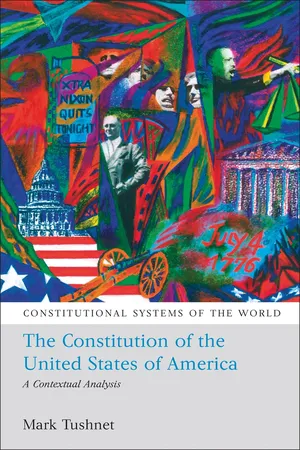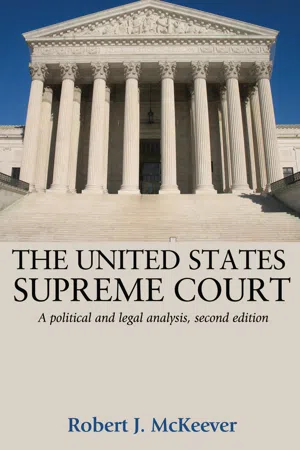Politics & International Relations
Judicial Branch
The judicial branch is one of the three branches of government, responsible for interpreting and applying the law. It consists of the court system, including the Supreme Court, and plays a crucial role in upholding the Constitution and ensuring the fair administration of justice. The judiciary's independence is essential for maintaining the system of checks and balances within a democratic government.
Written by Perlego with AI-assistance
Related key terms
3 Key excerpts on "Judicial Branch"
- eBook - ePub
The Judicial Branch of the Federal Government
Purpose, Process, and People
- Britannica Educational Publishing, Brian Duignan(Authors)
- 2009(Publication Date)
- Britannica Educational Publishing(Publisher)
HE JUDICIAL BRANCH OF GOVERMENTTHE JUDICIARY IN PERSPECTIVE
The judiciary is the branch of government whose task is the authoritative adjudication of controversies over the application of laws in specific situations. Conflicts brought before the judiciary are embodied in cases involving litigants, who may be individuals, groups, legal entities (e.g., corporations), or governments and their agencies. Conflicts that allege personal or financial harm resulting from violations of law or binding legal agreements between litigants—other than violations legally defined as crimes—produce civil cases. Judicial decisions in civil cases often require the losing or offending party to pay financial compensation to the winner. Crimes produce criminal cases, which are officially defined as conflicts between the state or its citizens and the accused (defendant) rather than as conflicts between the victim of the crime and the defendant. Judicial decisions in criminal cases determine whether the accused is guilty or not guilty. A defendant found guilty is sentenced to punishments, which may involve the payment of a fine, a term of imprisonment, or, in the most serious cases in some legal systems, stateimposed physical mutilation or even death.Judiciaries also frequently resolve administrative cases, disputes between individuals, groups, or legal entities and government agencies over the application of laws or the implementation of government programs. Most legal systems have incorporated the principle of state sovereignty, whereby governments may not be sued by nonstate litigants without their consent. This principle limits the right of litigants to pursue remedies against government actions. Nevertheless, the right of citizens to be free from the arbitrary, improper, abusive application of laws and government regulations has long been recognized and is the focus of administrative cases. - eBook - ePub
The Constitution of the United States of America
A Contextual Analysis
- Mark Tushnet(Author)
- 2008(Publication Date)
- Bloomsbury Publishing(Publisher)
4
The Constitutional Politics of the Judicial Branch
The US Supreme Court is at the top of a hierarchically organized, though somewhat complex, judicial system. There are two sub-systems of courts: one in the states and the other for the national government.1 The courts in the national judicial system are usually called the federal courts. State courts and the lower level federal courts have trial-level courts and appellate courts.2 Most American courts are generalist courts, with jurisdiction over claims of any sort.3 The US Supreme Court, on which this chapter focuses, has discretionary authority to hear appeals from decisions on matters of national law—statutory as well as constitutional—by the appellate courts in the national court system and by the highest state court authorized to decide the question of national law. Usually, but not always, that court is the state’s supreme court: in one notable case the US Supreme Court heard an appeal from a decision by the Police Court of the city of Louisville, Kentucky, which had imposed a small fine on the defendant, because under state law there were no appeals from such courts when small fines were imposed.4 - eBook - ePub
The United States Supreme Court
A political and legal analysis, second edition
- Robert J. McKeever(Author)
- 2016(Publication Date)
- Manchester University Press(Publisher)
4Politics and judicial reviewJudicial interpretation: the traditional viewWe saw in theprevious chapterthat the Supreme Court was created as a legal and judicial body, intended to complement rather than rival or duplicate the political branches of the federal government. Yet the very concept of judicial review in a constitutional democracy has proved to be inherently political. In this chapter, therefore, we examine the ways in which politics impinges upon judicial review and the various attempts that have been made to minimise or maximise the political potential of judicial review. We shall assess the extent to which the political characteristics of judicial review demand that we view the Court primarily as a political body.As we have seen (Chapter 2 ), in no. 78 of The Federalist Papers, Alexander Hamilton predicted that the Supreme Court would exercise not ‘will’, but ‘merely judgement’. This means that the Justices would be free from political bias or influence in their decisions and simply undertake constitutional interpretation as a neutral exercise in logic and law. An analogy could be made with the categorisation of species: asked to say whether the whale was a fish or a mammal, marine biologists would note the fundamental characteristics of fish and mammals, then those of whales, and decide whether the whale fitted one category’s set of criteria or the other. Our biologist would not be influenced by his or her preference for mammals over fish or society’s views on whaling. Logic and established scientific knowledge and principles would be his or her guide.Such a ‘scientific’ approach to law and constitutional adjudication held sway in legal circles well into the twentieth century. Take, for example, this statement by Justice Roberts in US v. Butler
Learn about this page
Index pages curate the most relevant extracts from our library of academic textbooks. They’ve been created using an in-house natural language model (NLM), each adding context and meaning to key research topics.


